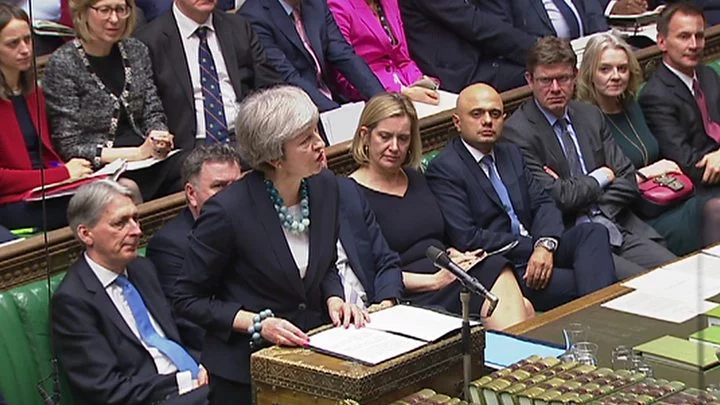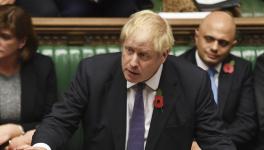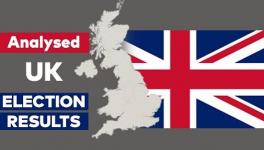Theresa May Survives Confidence Vote But Tough Times Await UK

On December 12, British Prime Minister Theresa May survived a no-confidence motion within her party. The motion came a day after May postponed the vote on the controversial draft Brexit deal. High drama followed the postponement of the vote on the deal, which had one Labour MP even getting kicked out for attempting to take away the speaker’s mace while a month-long petition for a no-confidence motion suddenly got the minimum number of required endorsements from 48 MPs. On the day of the no-confidence motion May declared that she would not lead the Conservative Party in the next general election, and eventually survived the intra-party no-confidence motion by a 200-117 vote.
If Brexit was the one thing that polarized Britain, essentially dividing the nation into two camps, ‘Remainers’ and ‘Brexiters’, the prime minister’s exit deal was a unifying factor, as it attracted strong opposition from people across the spectrum. From trade unions and Scottish and Irish nationalists to conservatives and British white supremacists and even a large number of the Prime Minister’s own party members, the opposition to the deal was widespread, for a variety of reasons.
So, what was it about the deal that had everyone hating on it? To begin with, the prime minister was never even a supporter of Brexit. In the popular referendum on Brexit held on June 23, 2016, Theresa May, who was the then Home Secretary in the David Cameron government, had voted to remain in the European Union (EU). She was never really on board, until she declared her candidature for the leadership of her party when David Cameron decided to stand down. After she secured the leadership of the Conservative Party and became the prime minister, succeeding David Cameron, she sought to work out an exit deal as was promised in the referendum.
Article 50 of the EU Treaty allows member states to voluntarily leave the Union. Britain has a time limit of twenty-four months, until March 29, 2019, to decide on a settlement deal for its exit. After over 500 days of excruciatingly slow negotiations, and four high profile resignations of cabinet ministers, Theresa May presented her draft deal to Britain on November 14. It was followed by a veritable rebellion from within her party itself, which ended in yesterday’s failed attempt at a no-confidence motion.
Despite having survived the vote, over 50 Tory (Conservative Party) MPs vowed to vote against the deal, along with the entirety of Labour and Scottish National Party (SNP) MPs numbering around 292 in the 650 seats large House of Commons. The Democratic Unionist Party (DUP) that gives outside support to the May government not only vowed to oppose the deal but also threatened to withdraw their “supply” votes. These votes are necessary for passing the annual budget, without which the government is effectively lost. Various experts have pointed out that despite how unsavoury the deal may be, it is the best that Britain could negotiate. But politically, this has effectively brought May’s career to an end. It should be noted that whatever reluctant support May had received from her cabinet for the deal, earlier in November, came largely from those who are either soft-Remainers, like herself, or those who turned to the pro-Brexit camp even though they had voted to remain in the EU in the 2016 referendum.
For the hardline Brexiters, both outside and within her party, the deal is not the clean and hard exit they expected it to be. According to the deal, UK would still be associated with the EU Customs Union, but without the voting rights over it. Apart from that, the deal does very little to alter the free trade and free movement of citizens and residents between Britain and the EU. All of this is only until the “transition period” for a full exit, which is supposed to end 21 months after the exit but can be extended as long as it is deemed necessary. This means that the UK can be indefinitely tied to the EU without any representation in its Council or the Parliament, where the decisions are made. The deal also requires the UK to stand by all the financial liabilities and commitments that it had made before it invoked Article 50. As far as the hardliners are concerned, this essentially compromises the sovereignty of Britain in its relationship with the EU. While there are no proposals coming forth from the Brexiters themselves, it almost seems like they would rather go crashing out of the EU without a deal than go through with the proposed one.
For Northern Ireland, the deal can potentially take the country back to the era of the Troubles. The Troubles was a three-decade-long period of constant ethno-nationalist violence between the secessionist Republicans, who wanted to reunite the territory with Ireland, on one side, and the Unionists and the British government on the other. The demarcation of the customs line was possibly the most difficult decision for Theresa May to make. There were three options that had very different set of implications. One was to leave the EU Customs Union, and put the international customs line between Northern Ireland and the Republic of Ireland, a “hard border”. This could potentially bring back secessionist and republican demands that were pushed under the rug with the Good Friday Agreement of 1998. The other option was to let Northern Ireland stay within the EU Customs Union, a “backstop”. This was not acceptable to the DUP which is a rigidly unionist party and does not want any level of integration (economic or political) with the Republic of Ireland to be solemnized by an isolated Britain. Upsetting the DUP would have spelt the end of the minority government and pushed the country into another general election, which the Tories may not be able to see through.
May chose a third option of participating with the Customs Union as an outsider, with little control and representation in it, for as long as a better arrangement is not arrived at, while also maintaining an Irish backstop indefinitely. This can only pacify the Republicans and the Unionists for a short while, since the economic and financial fallouts of such an arrangement will still resuscitate the politically polarising contentions of Ireland’s relationship with the United Kingdom. While the Prime Minister did concede the fact that it is the backstop that would kill the deal as it stands, she maintained that it was necessary to keep up the “hard-won peace” in Ireland.
However, the bid to pacify the Irish for the time being has angered the conservatives and the British nationalists at home, who demand a clean exit from the EU. While deferring the vote, May also hinted at how both her government and the EU may arrive at a deal that can do away with the backstop in the future.
Equally contentious is the question of Scotland, that was the only other country in the UK, apart from Northern Ireland to vote overwhelmingly in favour of remaining in the EU. The Scottish government, led by the SNP, has raised questions about the entire process of the negotiations and the 21-month uncertainty during the “implementation period” that is to follow the deadline of March 29, 2019. The SNP, the third largest party in the House of Commons with 35 MPs, has vowed to fight against the deal. The fact that special considerations were afforded to Northern Ireland, but not to Scotland, has attracted a vociferous opposition from several Scottish MPs. There are already suggestions being made about a second referendum for Scottish Independence from the UK, in the light of an exit from both the EU and the free trade zone with Europe. The workers and the people at large have taken the hit of an economy heading towards a free fall. Opinion polls, over the past month, have demonstrated that most British people are against the deal right now. Workers have already demanded guarantees against any possible compromise of the existing social welfare programmes, like the National Health Services, if and when the government is faced with an economic crisis post Brexit.
The only party that is even remotely content with the deal is the European Union. It is very unlikely that the EU will let the UK reverse its decision without serious compromises, and can put the nation into a fiscal purgatory that will take a long while before the country can ever bounce back. The EU had its chance to arm-twist Britain into a deal that is most beneficial to itself by essentially securing the British market with very little liability. The EU President, Jean-Claude Juncker, is set to meet Theresa May, who hopes for a renegotiation, but he has categorically stated that there is “no room for negotiations” and that the agreed-upon deal is the only possible one. Juncker has also stated that none of the other EU members are interested in rewriting the deal that came after a long overdrawn negotiation.
It must also be noted that, if all else fails, the UK government can unilaterally withdraw Section 50 and choose to remain in the EU. When asked about such a possibility, several leaders of the EU, including President Juncker, expressed an uneasiness about it. For them, this only exposes the fragility of the Union and, moreover, gives other members like Greece, Portugal and Spain, with growing Euroscepticism – a political tendency that is against the very idea of EU – a potent tool to pressurize the Union into changing its ways. Some analysts have speculated that a Brexit and its economic fallouts in the UK will serve as an example against any further Euroscepticism, making the EU stronger. As the deadline closes and an acceptable deal still seems impossible to arrive at, the May government is looking at Britain being pushed into a lasting period of uncertainty and severe recession, which might take it decades back.
Get the latest reports & analysis with people's perspective on Protests, movements & deep analytical videos, discussions of the current affairs in your Telegram app. Subscribe to NewsClick's Telegram channel & get Real-Time updates on stories, as they get published on our website.
























